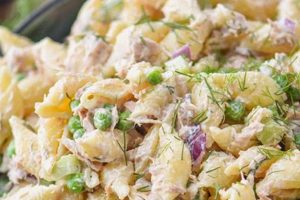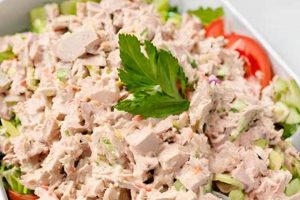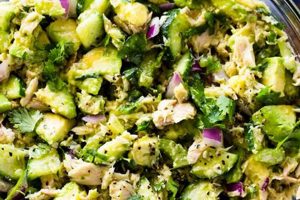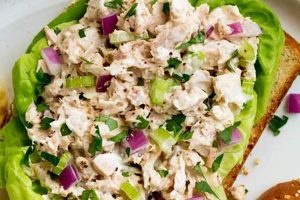A foundational dish in many cultures, a simple preparation of canned tuna combined with mayonnaise forms the core of this lunchtime staple. Common additions include chopped celery, onion, and seasonings like salt and pepper. This mixture is typically served between two slices of bread, though variations using crackers, lettuce wraps, or as a filling for tomatoes are also popular. A classic example involves mixing canned tuna in water or oil, drained, with mayonnaise, chopped celery, diced red onion, salt, and pepper, then serving this on white bread.
This readily accessible meal provides a quick and affordable source of protein and omega-3 fatty acids. Its adaptability allows for countless variations catering to individual preferences and dietary needs. Historically, the rise in popularity of canned tuna in the early 20th century contributed significantly to this dish’s emergence as a common household meal, particularly in North America and Europe. Its ease of preparation and relatively long shelf life further cemented its place as a convenient and economical food choice.
The following sections will delve into variations on this classic dish, exploring ingredient substitutions, different preparation methods, and nutritional considerations to provide a comprehensive guide to creating and enjoying this versatile meal.
Tips for an Enhanced Tuna Salad Sandwich
Elevating a simple tuna salad sandwich can be achieved through careful ingredient selection and thoughtful preparation. These tips offer guidance on maximizing flavor and texture.
Tip 1: Tuna Selection: Opt for high-quality canned tuna packed in water or oil. Oil-packed tuna offers a richer flavor, while water-packed provides a leaner option. Solid or chunk light tuna works well; albacore offers a firmer texture.
Tip 2: Mayonnaise Matters: The quality of mayonnaise significantly impacts the overall flavor profile. Experiment with different brands or consider making homemade mayonnaise for enhanced control over ingredients.
Tip 3: Crisp Celery: Ensure celery adds a satisfying crunch by using fresh, crisp stalks. Finely dice the celery for even distribution throughout the salad.
Tip 4: Onion Enhancement: Red onion adds a pungent bite, while milder options like white or yellow onion provide a subtler flavor. Finely dice the onion to prevent overpowering the other ingredients.
Tip 5: Seasoning Secrets: Salt and pepper are essential, but consider incorporating other seasonings like dill, paprika, or garlic powder for added depth of flavor.
Tip 6: Bread Selection: Choose bread that complements the tuna salad. Classic white bread is a popular choice, but whole wheat, sourdough, or rye offer interesting flavor combinations and texture variations.
Tip 7: Texture Play: Add chopped nuts, such as walnuts or pecans, for added texture and flavor complexity. Alternatively, incorporate chopped hard-boiled eggs for a protein boost and textural contrast.
By following these tips, one can transform a basic tuna salad sandwich into a culinary delight. Attention to detail in ingredient selection and preparation methods can significantly enhance the overall sensory experience.
By understanding these key elements, preparing a truly satisfying and flavorful tuna salad sandwich becomes achievable for any skill level. The following section concludes with suggestions for further exploration.
1. High-quality canned tuna
Canned tuna represents the foundational ingredient in a basic tuna salad sandwich recipe. Its quality significantly influences the overall flavor, texture, and nutritional value of the final product. Understanding the characteristics of high-quality canned tuna is crucial for achieving a desirable culinary outcome.
- Species and Cut:
Different tuna species offer varying flavor profiles and textures. Albacore typically possesses a firmer texture and milder flavor compared to skipjack or yellowfin. Chunk light tuna, a common and economical choice, offers a balance between flavor and affordability. Solid or chunk white albacore often commands a premium price due to its perceived superior quality.
- Packing Medium:
Tuna is commonly packed in either water or oil. Water-packed tuna offers a leaner option, suitable for those mindful of fat intake. Oil-packed tuna, often packed in olive oil or vegetable oil, contributes a richer flavor and moister texture to the salad. The choice depends on individual preference and dietary considerations.
- Sustainability and Sourcing:
Consumers are increasingly aware of sustainable fishing practices. Choosing tuna sourced from fisheries committed to responsible fishing practices ensures the long-term health of marine ecosystems. Certifications, such as those from the Marine Stewardship Council (MSC), can guide purchasing decisions toward environmentally conscious options.
- Freshness and Appearance:
While canned tuna has a long shelf life, checking the expiration date and examining the can for any signs of damage is essential. Upon opening, the tuna should appear firm and consistent in color, with a clean, fresh aroma. Avoid tuna that appears mushy or discolored, or has an off-putting odor.
The selection of high-quality canned tuna directly correlates with the overall success of a basic tuna salad sandwich. Investing in superior quality tuna enhances the flavor, texture, and nutritional content, elevating the dish from simple sustenance to a genuinely satisfying culinary experience. By understanding the nuances of tuna species, packing mediums, sustainability, and freshness, one can confidently choose the ideal canned tuna for their culinary needs.
2. Mayonnaise (quality matters)
Mayonnaise serves as a critical binding agent and flavor enhancer in a basic tuna salad sandwich recipe. Its quality directly impacts the overall palatability and sensory experience. A high-quality mayonnaise, typically characterized by a rich, creamy texture and balanced flavor profile, elevates the simple combination of tuna and other ingredients. Conversely, a low-quality mayonnaise, often exhibiting a thin consistency, excessive tanginess, or artificial aftertaste, can detract significantly from the final product. The interplay between mayonnaise and tuna creates the fundamental flavor base of the sandwich, emphasizing the importance of selecting a mayonnaise that complements, rather than overwhelms, the delicate flavor of the tuna.
Consider a scenario where two identical tuna salad recipes are prepared, differing only in the mayonnaise used. One utilizes a premium mayonnaise made with fresh eggs and high-quality oil, while the other incorporates a generic, budget-friendly mayonnaise. The resulting tuna salads will exhibit noticeable differences in texture and flavor. The premium mayonnaise will create a smooth, creamy tuna salad with a well-rounded flavor profile, enhancing the natural flavors of the tuna. The generic mayonnaise, on the other hand, might result in a thinner, less flavorful salad, potentially introducing unwanted tanginess or artificial notes. This example highlights the practical significance of mayonnaise quality in determining the overall success of a basic tuna salad sandwich.
Understanding the pivotal role of mayonnaise quality empowers one to make informed decisions when preparing this seemingly simple dish. While budget constraints might necessitate compromises in certain ingredients, prioritizing a higher-quality mayonnaise can significantly elevate the overall culinary experience. The subtle nuances in flavor and texture imparted by a superior mayonnaise can transform a basic tuna salad sandwich from a mundane meal into a truly satisfying culinary creation. This attention to detail underscores the importance of recognizing and appreciating the impact of each ingredient on the final product.
3. Crisp Celery
Celery contributes a crucial textural element to the basic tuna salad sandwich recipe. Its crispness offers a refreshing counterpoint to the softness of the tuna and mayonnaise, preventing the sandwich filling from becoming overly homogenous. This textural contrast enhances the overall sensory experience, providing a satisfying bite. Beyond texture, celery imparts a subtle, vegetal flavor that complements the savory notes of the tuna. This delicate flavor enhancement adds depth and complexity to the overall profile of the sandwich, preventing it from tasting bland or one-dimensional.
Consider a tuna salad made without celery. The resulting mixture, while palatable, might lack textural intrigue. The absence of celery’s characteristic crunch could result in a dense, paste-like consistency, diminishing the overall enjoyment of the sandwich. Conversely, incorporating limp, wilted celery would not only fail to provide the desired crunch but also introduce an unpleasant, watery texture. This comparison illustrates the importance of crisp celery in achieving the ideal textural balance within a basic tuna salad sandwich. A real-world example can be observed in commercially produced tuna salads, where crisp celery is almost invariably included, underscoring its recognized contribution to both texture and flavor.
Understanding the role of crisp celery in the basic tuna salad sandwich recipe allows for informed ingredient selection and preparation. Choosing fresh, firm celery stalks and employing proper storage techniques are essential for maintaining optimal crispness. This knowledge translates into a more satisfying culinary experience, highlighting the practical significance of seemingly minor details. Achieving the perfect balance of flavors and textures in a basic tuna salad sandwich relies on a holistic understanding of each ingredient’s contribution, with crisp celery playing a crucial role in this culinary equation.
4. Finely diced onion
Finely diced onion constitutes a key flavor component within a basic tuna salad sandwich recipe. Its presence introduces a pungent, slightly sweet, and savory dimension that complements the richness of the tuna and mayonnaise. The size of the dice plays a crucial role; finely dicing the onion ensures even distribution of flavor throughout the salad while preventing overpowering onion dominance and maintaining a pleasant texture.
- Flavor Enhancement
Onion’s inherent sulfur compounds contribute a characteristic pungency that balances the inherent richness of the mayonnaise and the mild flavor of the tuna. This pungency, when properly balanced, adds depth and complexity to the overall flavor profile. Consider the difference between a tuna salad with and without onion; the former offers a more nuanced and complete flavor experience, while the latter might taste comparatively bland.
- Textural Contribution
Finely diced onion provides a subtle textural variation within the sandwich filling. While not as prominent as the crunch of celery, the small pieces of onion offer a slight resistance, enhancing the overall mouthfeel. This textural nuance contributes to a more engaging sensory experience.
- Variety and Choice
Different onion varieties offer distinct flavor profiles, allowing for customization. Red onion imparts a sharper, more pungent flavor, while white or yellow onions offer milder sweetness. Choosing the appropriate onion variety allows for tailoring the tuna salad to individual preferences. For example, a sweeter onion might complement a tuna salad intended for a child’s palate, while a more pungent red onion might suit an adult seeking a bolder flavor.
- Balancing Act
The quantity of onion used requires careful consideration. Too much onion can overpower the other ingredients, while too little might render its contribution negligible. Achieving the correct balance ensures that the onion enhances, rather than dominates, the overall flavor profile. This balance depends on individual preferences and the specific onion variety used.
The inclusion of finely diced onion in a basic tuna salad sandwich recipe demonstrates the impact of seemingly minor ingredients on the overall culinary outcome. The onion’s contribution extends beyond mere flavor enhancement, influencing texture and offering opportunities for customization based on individual preferences. Understanding the multifaceted role of finely diced onion allows for a more nuanced approach to preparing this classic dish, elevating it from simple sustenance to a carefully crafted culinary experience.
5. Seasoning (salt, pepper, etc.)
Seasoning represents a critical stage in the preparation of a basic tuna salad sandwich recipe. It elevates the inherent flavors of the core ingredients tuna, mayonnaise, celery, and onion transforming a bland mixture into a palatable and enjoyable culinary experience. Careful consideration of seasoning choices and quantities profoundly impacts the final product, demonstrating the significant influence of this seemingly simple step.
- Salt’s Foundational Role
Salt acts as a flavor enhancer, amplifying the inherent savory notes of the tuna and other ingredients. It modulates the overall taste, reducing perceived bitterness and enhancing sweetness. A tuna salad inadequately seasoned with salt tastes flat and unappealing, whereas excessive salt renders it inedible. The precise amount depends on individual preference and the saltiness of other components, such as the mayonnaise or type of tuna used.
- Pepper’s Complexity
Black pepper introduces a layer of complexity with its subtle heat and earthy notes. Freshly ground black pepper offers superior flavor compared to pre-ground pepper due to the volatile oils released during grinding. The quantity used depends on desired pungency levels and personal preference. White pepper, milder than black pepper, can be substituted for a gentler flavor profile.
- Expanding the Flavor Profile: Herbs and Spices
Beyond salt and pepper, other seasonings can further enhance a basic tuna salad sandwich. Dill, with its bright, slightly tangy flavor, complements the savory notes of tuna. Paprika adds a subtle smokiness and vibrant color. Garlic powder introduces a savory depth. These additions, used judiciously, create a more complex and nuanced flavor profile. Experimentation with different herb and spice combinations allows for customization and personalization.
- Balancing Act: Seasoning Adjustments
Seasoning is not a static process. It requires ongoing assessment and adjustment throughout the preparation process. Initial seasoning should be conservative, with additional increments added gradually, tasting after each addition. This iterative approach allows for precise control over the final flavor profile, preventing over-seasoning. Factors influencing seasoning adjustments include the salinity of the tuna, the type of mayonnaise used, and individual palate preferences.
The judicious use of seasoning transforms a basic tuna salad sandwich from a simple combination of ingredients into a cohesive and flavorful culinary creation. Understanding the roles of salt, pepper, and other seasonings, and employing a balanced approach to their application, significantly impacts the overall palatability and enjoyment of this classic dish. This attention to detail highlights the crucial role seasoning plays in achieving culinary excellence, even in seemingly basic recipes.
6. Bread Choice
Bread choice represents a crucial decision in crafting a basic tuna salad sandwich recipe. The bread acts as both a delivery system and a flavor component, significantly influencing the overall sensory experience. Its texture, flavor, and structural integrity directly impact the sandwich’s palatability and enjoyment. Careful consideration of bread options ensures a harmonious balance between the filling and its edible vessel.
- Classic White Bread
Classic white bread, with its soft texture and neutral flavor, provides a blank canvas that allows the tuna salad to take center stage. Its mild sweetness subtly complements the savory filling, creating a familiar and comforting combination. This ubiquitous choice, often preferred for its affordability and availability, offers a reliable base for a basic tuna salad sandwich. Examples include standard sliced white bread, enriched white bread, and milk bread.
- Whole Wheat Bread
Whole wheat bread introduces a nuttier, slightly earthy flavor profile and a denser texture compared to white bread. Its added fiber content contributes to a more substantial and satisfying meal. The robust character of whole wheat bread can stand up to bolder flavored tuna salads, creating a textural and flavor contrast. Examples include whole wheat sandwich bread, multigrain bread, and seeded whole wheat bread.
- Sourdough Bread
Sourdough bread offers a distinctive tangy flavor derived from its unique fermentation process. This tanginess can either complement or contrast the flavors of the tuna salad, depending on the other ingredients used. Its characteristic chewy texture adds another dimension to the sandwich, creating a more complex sensory experience. San Francisco sourdough, with its pronounced sourness, provides a distinct backdrop for the tuna salad.
- Rye Bread
Rye bread possesses a dense texture and a distinct, slightly spicy flavor profile derived from rye flour. Its robust character complements tuna salads with bolder flavor additions, such as dill or horseradish. The assertive flavor of rye bread can create a more complex and savory sandwich. Examples include light rye, dark rye, and marble rye.
The careful selection of bread elevates the basic tuna salad sandwich from a simple meal to a considered culinary creation. The interplay between bread and filling creates a synergistic relationship where textures and flavors harmonize to deliver a satisfying and enjoyable experience. Choosing the appropriate bread, whether classic white, whole wheat, sourdough, or rye, depends on individual preferences and the specific flavor profile of the tuna salad. This understanding of bread’s crucial role underscores the attention to detail required for achieving culinary excellence, even in seemingly simple recipes.
Frequently Asked Questions
This section addresses common inquiries regarding the preparation and enjoyment of tuna salad sandwiches, offering practical guidance and clarifying potential points of confusion.
Question 1: How can one prevent a tuna salad sandwich from becoming soggy?
Sogginess often results from excess moisture in the tuna salad or from the bread absorbing moisture over time. To mitigate this, thoroughly drain the canned tuna before mixing. Additionally, consider adding a barrier between the filling and the bread, such as lettuce leaves or tomato slices. Assembling the sandwich immediately before consumption also minimizes moisture transfer.
Question 2: What are suitable alternatives to mayonnaise in tuna salad?
Plain Greek yogurt, mashed avocado, or a combination of hummus and lemon juice offer healthier alternatives to mayonnaise, reducing overall fat content while providing creamy texture and distinct flavors. These substitutions cater to dietary restrictions or preferences while maintaining the desired consistency.
Question 3: How long can tuna salad be safely stored?
Tuna salad, properly refrigerated in an airtight container, typically remains safe for consumption for three to five days. However, factors such as ambient temperature and ingredient freshness can influence shelf life. Discarding tuna salad exhibiting off-odors or discoloration is recommended, regardless of storage time.
Question 4: Can one freeze tuna salad?
While freezing tuna salad is possible, it’s generally not recommended. Freezing alters the texture of the mayonnaise, often resulting in a separated and less desirable consistency upon thawing. The flavors of the other ingredients may also be negatively affected. Freshly preparing tuna salad is generally preferred for optimal quality.
Question 5: How can one enhance the nutritional value of a tuna salad sandwich?
Incorporating nutrient-rich additions, such as chopped vegetables like bell peppers, cucumbers, or carrots, boosts vitamin and mineral content. Adding sprouts or seeds further enhances nutritional density. Choosing whole-grain bread provides additional fiber and nutrients compared to refined white bread.
Question 6: What are some creative variations on the classic tuna salad sandwich?
Tuna salad’s versatility allows for numerous adaptations. Serving the tuna salad on lettuce wraps or in scooped-out tomatoes offers low-carbohydrate alternatives. Using croissants or pita bread instead of traditional sliced bread creates different textural and flavor experiences. Incorporating ingredients like chopped apples, grapes, or dried cranberries introduces sweetness and textural complexity.
Understanding these frequently addressed concerns provides a foundation for successful tuna salad preparation and enjoyment. Awareness of storage guidelines, ingredient substitutions, and potential variations empowers informed choices aligned with individual dietary needs and preferences.
The following section concludes this exploration of the basic tuna salad sandwich recipe, offering final thoughts and summarizing key takeaways.
Conclusion
This exploration of the basic tuna salad sandwich recipe has illuminated the critical role of ingredient selection and preparation techniques in achieving a truly satisfying culinary outcome. From the importance of high-quality canned tuna to the nuanced impact of seasoning choices, each component contributes significantly to the final product. The seemingly simple combination of tuna, mayonnaise, celery, and onion, when thoughtfully considered, transforms from mere sustenance into a carefully crafted culinary experience. Understanding the subtle interplay of flavors and textures empowers informed decision-making, elevating this classic dish beyond its humble origins.
The basic tuna salad sandwich recipe, while seemingly straightforward, offers a canvas for culinary creativity and personal expression. Its adaptability allows for endless variations, catering to individual preferences and dietary needs. Further exploration of ingredient combinations, bread choices, and alternative preparations promises continued enjoyment and discovery within this timeless culinary staple. The enduring appeal of the basic tuna salad sandwich recipe lies not in its simplicity, but in its potential for continuous refinement and personalized interpretation.






